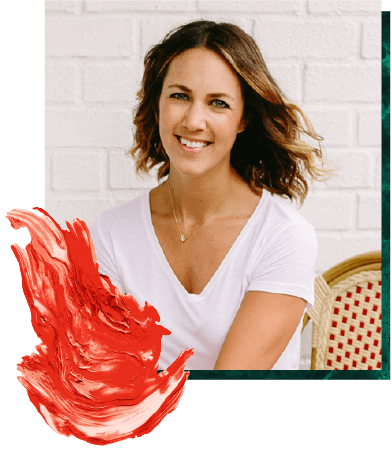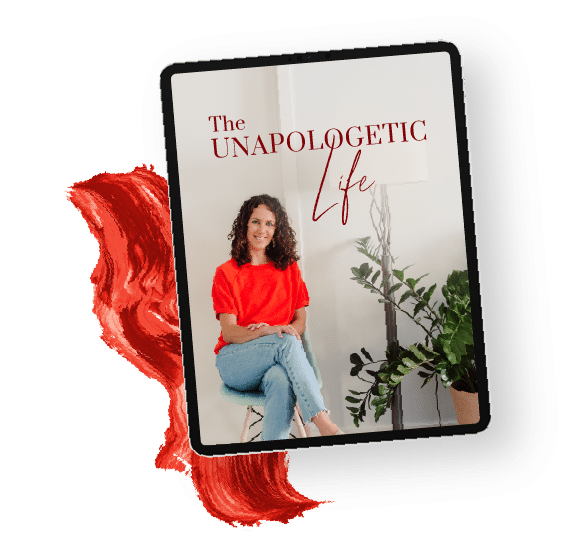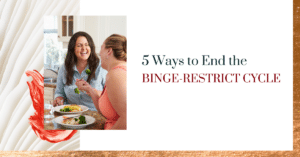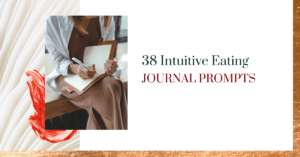The Hunger-Fullness Scale

The hunger-fullness scale is a practical tool that can be helpful as you work on building awareness and getting in tune with your hunger and fullness cues. Read on to learn more about how to use the hunger and fullness scale, including the most common mistake I see people make when first using the tool.

After many years of dieting or overriding your internal body cues in favor of external rules, restrictions, “shoulds” or “shouldn’ts,” the idea of listening to what your body is telling you may seem challenging.
Many of the people I work with tell me that they have no idea what “slight” hunger feels like; they typically only notice the more extreme “starving” forms of hunger. Others say that they never really feel full or satisfied (which, as I’ll talk about shortly, is very different from fullness). Other folks find that they do feel their hunger and fullness cues but have trouble following them.
One tool that can help you begin to notice, build awareness around, and reconnect with your hunger and fullness cues is the hunger-fullness scale.
The Hunger and Fullness Scale
Hunger can be felt and experienced in a variety of ways. It is a subjective feeling and can differ from person to person. Contrary to popular belief, hunger is not only felt in the stomach. For some people, a growling stomach is one of the last signs of hunger they feel, which comes on only at the point at which they are completely ravenous (and ideally you are able to eat before it gets to that point!).
Here are some ways in which you may sense hunger:
- Energy: Tired, low-energy, sluggish
- Head: Trouble concentrating, headache, dizzy, unable to focus, feeling light-headed
- Mood: Irritable, on edge, cranky (the classic “hanger”), uninterested
- Stomach: Growling or rumbling, slight pain (i.e., a hunger “pang”), empty feeling, a gnawing feeling
A hunger and fullness scale is a tool that allows you to tune into your body and rate your level of hunger and fullness on a scale from 1 to 10.
The hunger portion of the scale ranges from 1-5:
- A 5 is neutral—when you are not necessarily hungry, but you’re also not full.
- Working down the scale, a 4 indicates the early feelings of hunger; you could eat and are even ready to eat, but you don’t feel a lot of urgency.
- Next is a 3, which is when you feel very hungry and are looking forward to eating; you feel some urgency at this point.
- A step below that is 2, which is where you may begin to feel irritable, have a headache, and feel ravenous.
- At the low end of the scale you have 1, which is a painful, primal feeling of hunger. At this level, you may feel dizzy, shaky, or nauseated because you are so hungry.

How to Use the Hunger-Fullness Scale
It is important to use the hunger-fullness scale as a guide rather than feeling the need to follow the numbers “perfectly.” These numbers, as I’ve just described them, may not best suit your experience or sensations of hunger.
For example, one of my clients starts to get a headache as an early sign of hunger, which puts her around a 4 on the scale. Another client never experiences an “empty” or growling stomach feeling, even when she’s at a 1 or 2.
As you practice tuning into your body and bringing awareness to your hunger cues, it may be helpful to personalize the hunger-fullness scale based on your hunger cues. Make note of what feelings and sensations seem to correlate with the ravenous/starving low end of the scale and which ones seem to signal earlier signs of hunger.
If you have been chronically dieting, restricting, or are in recovery from an eating disorder, it may be too soon to start using the hunger scale. The priority for you is to eat consistent meals and be eating enough calories and carbohydrates.
For most people, eating experiences feel best when eating occurs somewhere between a 3 and 4 on the scale. While this may not always be possible, eating before you hit that extreme or painful hunger point helps to build back trust with your body (not to mention it generally feels more comfortable!).
Remember, hunger is a biological signal, and the more you ignore it or try to push through without eating, the more your body distrusts that you are going to feed it when it cues you to.
An Important Note About the Hunger-Fullness Scale:
If using the 1 to 10 hunger-fullness scale feels overwhelming, or you notice that it triggers any diet mentality thoughts, simply start by identifying whether your stomach feels comfortable, uncomfortable, or neutral. If you try to use the scale, remember you’re not striving for perfection (repeat to yourself: find the gray area).
Sometimes you don’t know what your body is feeling, and that is okay! Just the simple act of tuning in to see if it feels comfortable or not is often enough.
Why Honoring Your Hunger is So Important
Ignoring hunger, or frequently waiting until you are ravenous before eating, can cause increased cravings and increased hunger cues. Your body doesn’t know whether you are going to feed it, and to do its job to keep you alive, it compensates by sending more and more signals to get you to eat.
Waiting to eat until you are extremely hungry can feel really uncomfortable. You may feel so much urgency to eat at that point that your eating habits become more quick and chaotic, which is typically not a satisfying way to eat. Not only are you more apt to eat until you feel uncomfortably full but you may also experience bloating, gas, and indigestion.
Plus, when people end up at the “very full” end of the hunger-fullness scale, they often feel guilty and they vow not to eat so much next time. This person’s thought of, “I won’t overeat this time,” is interpreted by their body as, “Starvation is coming; better increase signals to make sure they eat enough to stay alive.”
By ignoring their hunger cues, or just not being aware of the more subtle signs of hunger, and by having guilty or food police thoughts, this person stays stuck in the diet cycle.
If you are someone who rarely feels hunger until you hit a 2, or even 1, on the scale and feel “totally ravenous,” then it can help to practice noticing the earlier, sometimes more subtle sensations of hunger.
If using the 1 to 10 hunger-fullness scale feels overwhelming, or you notice that it triggers any diet mentality thoughts, simply start by identifying whether your stomach feels comfortable, uncomfortable, or neutral. If you try to use the scale, remember you’re not striving for perfection (repeat to yourself: find the gray area). Sometimes you don’t know what your body is feeling, and that is okay! Just the simple act of tuning in to see if it feels comfortable or not is often enough.
Stay Present-Focused
When you honor your inner wisdom, you are present-focused. You are noticing and becoming more attuned to how your body feels in that moment and honoring that feeling. If you find yourself saving up for meals or choosing (or avoiding) certain foods based on what you might eat later, you are future-focused.
It is impossible to know what your body will need later on or how you will feel when you get there. When you base current eating decisions on what you think might happen in the future, it will prevent you from being able to reconnect with your body cues fully. Bring yourself back into the present moment, check-in with your body, and challenge yourself to honor your body’s desires.
What About Fullness?
You may have noticed that I’ve introduced the hunger-fullness scale, but I haven’t brought up much related to fullness. I’m doing this intentionally.
You may be tempted to jump ahead to the feel your fullness part of intuitive eating because you think that honoring your hunger cues isn’t your issue and stopping when full is. (I hear this all the time.)
Trust me when I say, “Wait.” If you are not honoring every hunger signal (by eating), then you’re going to find it next to impossible to stop when you feel full, which is why honoring your hunger needs to come before feeling your fullness. Otherwise, and I say this with love and compassion, you’ll just be turning intuitive eating into a diet.
It’s Not Just About Hunger and Fullness Cues
Intuitive eating involves body knowledge – like building awareness of your body’s hunger and fullness cues – but it also involves brain knowledge. There are many things that may blunt our hunger cues, but that doesn’t mean we don’t need to eat.
For example, many people don’t feel hunger cues when they’re busy, stressed, anxious, or have consumed a lot of caffeine. I see this a lot with my clients, where they don’t eat much during the first half of the day (sound familiar to anyone?). They then feel famished in the afternoon and evening and often end up eating to the point of discomfort.
Intuitive eating includes eating when you might not feel typical hunger cues (and/or making time to eat when you’re busy or distracted). This is the brain knowledge piece: you know if you don’t eat you will feel over-hungry later, or it will affect your energy levels, or your mood.
Listening to your body is not just about hunger and fullness, it’s about ensuring you’re adequately nourished and checking in with other cues – mood, energy levels, and sleep, that all can be affected by inadequate nourishment.
Looking for more support?
My team and I offer virtual one-on-one coaching and can help you get out of the all-or-nothing mindset, find the gray area, and make peace with food and your body – check out our nutrition coaching packages to learn more.
You can also check out my Unapologetic Eating 101 Course, an online, self-paced intuitive eating and body image program to liberate yourself from dieting and make peace with food and your body.
This post was updated with support from Autumn Rauchwerk (@autumnrosewellness), a Dietetic Intern and Registered Yoga Teacher based out of Brooklyn, NY.
Another version of the hunger-fullness scale:

Author Bio
This article was written and reviewed by Alissa Rumsey, MS, RD, CSCS, a registered dietitian and Certified Intuitive Eating Counselor. She specializes in weight-inclusive care, intuitive eating, body image healing, mindfulness, self-compassion, and healing from chronic dieting, disordered eating, and eating disorders. Alissa holds a Bachelor’s Degree in Nutrition and Exercise Science, and a Master’s Degree in Health Communications, and is also an NSCA Certified Strength and Conditioning Specialist.
17 Comments
Leave a Comment
share the love

about
Alissa Rumsey, RD.
Alissa Rumsey, MS, RD, CDN, CSCS (pronouns she/her/hers) is a registered
dietitian, nutrition therapist, certified intuitive eating counselor, and the author of
Unapologetic Eating: Make Peace With Food and Transform Your Life. Alissa is
passionate about helping people reclaim the space to eat and live,
unapologetically.

A twice-a-month round-up of inspirational stories, lessons, practical tips and encouragement for living your most authentic, unapologetic life.
The Unapologetic Life
RECENT POSTS

The Unapologetic Life
A twice-a-month round-up of inspirational stories, lessons, practical tips and encouragement for living your most authentic, unapologetic life.











Great post :). I use the hunger scale analogy a lot in my everyday counseling job, and it seems to resonate pretty well with people. I love the idea of questions to ask yourself if you don’t seem to have normal hunger cues. Thanks!
Thanks Maria!
Hi Alissa,
I also love using the hunger and fullness scale with my patients, but I’m curious how you go about helping your clients who “never feel hungry” and they can’t identify any symptoms such as those on the scale. Where do you start in that case? Any helpful exercises to put people back in touch with physical or emotional signs of hunger, aside from asking those helpful questions you mentioned? Thanks!
Great question Casey! I like to start with “section” 1-5 of the hunger/fullness scale – i.e. the hunger portion. Starting with a “1” (aka starving/extremely hungry) since this is often the easiest for people to feel/connect to – I ask my clients to describe what this feels like in their body. What body sensations do they feel? Not just emotions/feelings (like irritable or hangry) but how does this actually feel in their body? Then we work to start to reconnect to the body and being to pay attention to the earlier signs of hunger and what it feels like in their body. This takes time and a lot of trial and error. If they are really feeling very little appetite cues, then eating on a schedule is important until those cues start to return. Hope this helps!
What do you do when you don’t know if your hunger signs are actual hunger or something psychological(boredom, sadness, stress etc)? And what do you do when you don’t know when you’re full or ever feel full. Some days I can eat one meal a day and be fine especially if I’m busy working around the house or have a lot going on for the day, and other days I feel like I could eat everything in sight (especially if I’m bored or sitting at work)? I hardly ever experience the “hangry” feeling. If anything id say that 3 or 4 is something I may experience and then when I eat, I never truly feel satisfied or satiated. Even if I know I’m stuffed I can still keep eating. Especially if its food I really enjoy. Its more like I don’t want to waste it or miss out eating this because I don’t know when I’ll eat it again, which sounds more psychological than the physical cues. I’m trying to understand the intuitive eating thing and trying to break away from dieting all the time so I’m curious how start learning and feeling the cues.
Really love this idea, and thank you for sharing! One question I do have is regarding choosing your favourite foods that you love to eat. In my case, these will almost always lead to bingeing. Would you recommend choosing foods that provoke no emotional response?
Hi Rhiannon, great question! I answer this question in more detail in this blog post: https://alissarumsey.com/intuitive-eating/how-to-stop-overeating/. Hope that helps!
I have a client who gets nauseous when she eats food other than bread and starch. She knows she needs to eat fruit and/or milk with her cheerios but she gets a sick feeling. She is going to see a doctor to see if she has any allergies. Is that common for someone to feel nausea when she eats other food?
Hi Becky, I can’t specifically comment on this without knowing her full history to understand what might be going on – a referral to her physician is a great idea though!
Hi. I’ve become underweight and i’m tired of counting calories, starving myself/fasting and being restrictive and scared of food so I started Intuitive Eating yesterday and I don’t know if i’m doing it correctly. I’m trying my best to stop counting calories and focus on what my body needs. Now I feel like i’m eating more than needed, but when I count calories, I eat less. I want to be healthy and I don’t want this unhealthy mindset with food and my body. I need help )’:
Hi there, I highly recommend reaching out to a professional about this, here is a great place to start: https://www.nationaleatingdisorders.org/help-support/contact-helpline
Your site is beautiful! And very informative! I have been researching Intuitive Eating and have adopted some of the tactics. Still a work in progress for sure!
Thanks so much Mandy!
Hello, I’ve recently stopped dieting and restrictive eating. I’m eating consistent meals as recommended to get in touch with hunger and fullness. I feel hunger but twice a day at most if it even shows up. Is this normal? I don’t want to over eat by eating when I’m not hungry for the third meal. It’s confusing because I have the hunger too but usually it’s a ravenous feeling and not gentle either.
Hi Alaina – thanks for sharing your experience! Hunger cues can be hard to notice at first especially when you’ve been dieting/restricting – our cues can actually atrophy, so what you’re experiencing is normal. As you mentioned, this is why eating consistent meals/snacks throughout the day (most people do best eating every 3-5 hours, i.e. 3 meals + several snacks) is important — because this will help your hunger cues start to come back, and because when you first stop restricting, your hunger cues are usually not the best indicator of when/how much you need to eat (since they’ve likely atrophied). If you feel ravenously hungry, that could mean that you aren’t eating enough when you are eating and/or that you may need to eat more frequently throughout the day. It’s very normal at first to not feel hunger until/unless it’s that “ravenous” feeling like a 1-2 on the hunger scale. Keep eating consistently throughout the day, and enough at each meal, and try to notice what those earlier signs of hunger feel like. Again this takes time and practice, so patience is key 🙂 I’d also recommend working with a weight-inclusive dietitian who can help you make sure you’re eating enough and help you start to get back in touch with these cues. If you’re looking for more support, you’re welcome to check out the 1:1 work that my team and I do: https://alissarumsey.com/nutrition-coaching. Thanks again for your question!
Hi Alissa!
Thanks for this great info.
Where can I find more information on applying the hunger scale in my food choices? Can you recommend any books?
Hi Steve, great question – there are several books that talk about the hunger scale more. My book Unapologetic Eating (https://alissarumsey.com/book) has a chapter dedicated to reconnecting to your body cues and using the hunger scale; there’s also a part of the book that speaks to nutrition and food choices. You could also check out the book Gentle Nutrition by Rachael Hartley, if you’re looking for more specific nutrition information. I hope this helps!